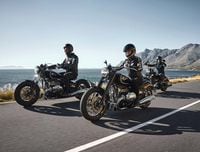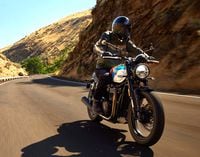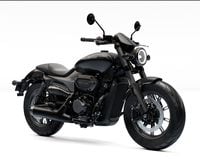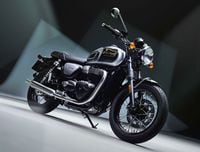To my way of thinking, myths are among our worst enemies. At best, buying into them can make you look foolish and, at worst, get you seriously hurt or dead. Accordingly, I like to do a little periodic "myth busting" just to keep everyone on their toes. If you accept any of the following as gospel, feel free to make your case, but be forewarned: Your words may come back to haunt you in a future issue.
"Loud pipes save lives." I'm not going to say this is the silliest thing I've ever heard, but it's up there. Supporters of this myth tend to use anecdotal evidence to prop it up, usually of the "a truck was about to cut me off when he heard my pipes and veered back into his own lane" type. You can argue this one all you want, but I don't buy it. Maybe your loud pipes startled some poor schlep as you blasted past, causing him to swerve, but if he heard you, why was he about to cut you off in the first place? Since I've never seen any empirical evidence to support the loud-pipes theory, I'll go on record as saying if anyone can make a case based on scientific results, I'll be happy to run it in the next issue with a full apology.
"You can't use synthetic oil in a motorcycle engine; it'll make the bearings skid and wipe out the motor." The theory here is that synthetic oil is so slippery that it prevents the rolling elements of ball and roller bearings from turning. It's an interesting idea, but like most myths, it's just a lot of smoke. The fact is that synthetic oil is no more "slippery" than any other oil, and using it in a roller-bearing engine won't cause the least bit of harm.
"Don't use the front brake—it'll toss you over the handlebars." This is the oldest one on the books, and I seriously doubt anyone still believes it, but I had to include it for old time's sake. My guess is this tale got started back in the days of dirt roads, when a good squeeze on the front brake lever could lock the front wheel and cause a slide. Why it persisted as long as it did says a lot about people's willingness to believe a good story despite evidence to the contrary.
"Always burn high-octane gas—your bike will make more power." This one certainly sounds plausible, but here's why it isn't: From an energy-producing standpoint, there's not much difference between high- and low-octane gas. However, high-octane fuel is formulated to resist detonation, and as such it's less volatile, meaning it's harder to ignite and burns slower than low-octane fuel. When an engine is designed to run on regular, the anti-detonation characteristics of high-test gas can work against it to cause hard starting, poor idling and, in some cases, reduced power. The truth is that burning high-test gas in an engine that doesn't require it is a waste of money and may actually reduce power.
"Never use anti-seize (or grease) on a nut or bolt—it'll make the threads slick, and they'll come loose." Like most myths, this one illustrates a fundamental misunderstanding of certain realities.
Think of a bolt as a spring; when it’s tightened, it stretches slightly and applies a predetermined clamping force to whatever you’re trying to hold together. To do its job properly, the bolt must be properly torqued to a predetermined value. When hardware is assembled dry, some torque is used up overcoming friction between the threads. This generally leads to an undertorqued—read that as loose—bolt. Lubricating a fastener will reduce friction as the bolt is tightened and provide the proper torque setting. So unless the manufacturer states otherwise (and there are instances where they will), always lightly oil a threaded fastener before installing it.
As you can see, most myths appear to have some basis in reality, and that’s what makes them dangerous. They’re also a way to explain the unexplainable without doing a whole lot of research. Since our ancestors had no way of knowing what actually caused thunder, they accepted that it was formed by Thor riding through the heavens in a cart pulled by fire-snorting goats.
The problem is that accepting a myth at face value often has unpleasant repercussions. In the past, it sometimes meant sacrificing a virgin or two to appease the gods, while in modern times, it may mean spending the rest of your life hooked to a feeding tube ’cause you bought into a really dumb myth like “helmets kill more riders than they save.” Which, I suppose, is a form of human sacrifice after all, isn’t it?
Craving more motorcycle myths? Here you go!
/cloudfront-us-east-1.images.arcpublishing.com/octane/7SPYGKLVSDYHBE5AHJ5KTUBESQ.jpg)
/cloudfront-us-east-1.images.arcpublishing.com/octane/H6Z2IC7WYRBXZNQS4MI3SZ5KPQ.jpg)
/cloudfront-us-east-1.images.arcpublishing.com/octane/IWO5T5PBT5E4HFQ5GK47H5YXR4.jpg)
/cloudfront-us-east-1.images.arcpublishing.com/octane/OQVCJOABCFC5NBEF2KIGRCV3XA.jpg)
/cloudfront-us-east-1.images.arcpublishing.com/octane/F3O2DGLA4ZBDJGNVV6T2IUTWK4.jpg)
/cloudfront-us-east-1.images.arcpublishing.com/octane/ZXYQE3MHLFDSPKNGWL7ER5WJ4U.jpg)
/cloudfront-us-east-1.images.arcpublishing.com/octane/RDF24VM7WVCOBPIR3V3R4KS63U.jpg)
/cloudfront-us-east-1.images.arcpublishing.com/octane/W7RSIBFISNHJLIJESSWTEBTZRQ.jpg)
/cloudfront-us-east-1.images.arcpublishing.com/octane/AERA26ENRNBW3K324YWCPEXYKM.jpg)
/cloudfront-us-east-1.images.arcpublishing.com/octane/YWX3YX7QBBHFXFDMEEEKRG4XJE.jpg)
/cloudfront-us-east-1.images.arcpublishing.com/octane/I7OKI53SZNDOBD2QPXV5VW4AR4.jpg)
/cloudfront-us-east-1.images.arcpublishing.com/octane/IH52EK3ZYZEDRD3HI3QAYOQOQY.jpg)
/cloudfront-us-east-1.images.arcpublishing.com/octane/K2FSAN7OWNAXRJBY32DMVINA44.jpg)
/cloudfront-us-east-1.images.arcpublishing.com/octane/G4XK7JL24FCUTKLZWUFVXOSOGE.jpg)
/cloudfront-us-east-1.images.arcpublishing.com/octane/JJNXVAC27ZCDDCMTHTQZTHO55Y.jpg)









